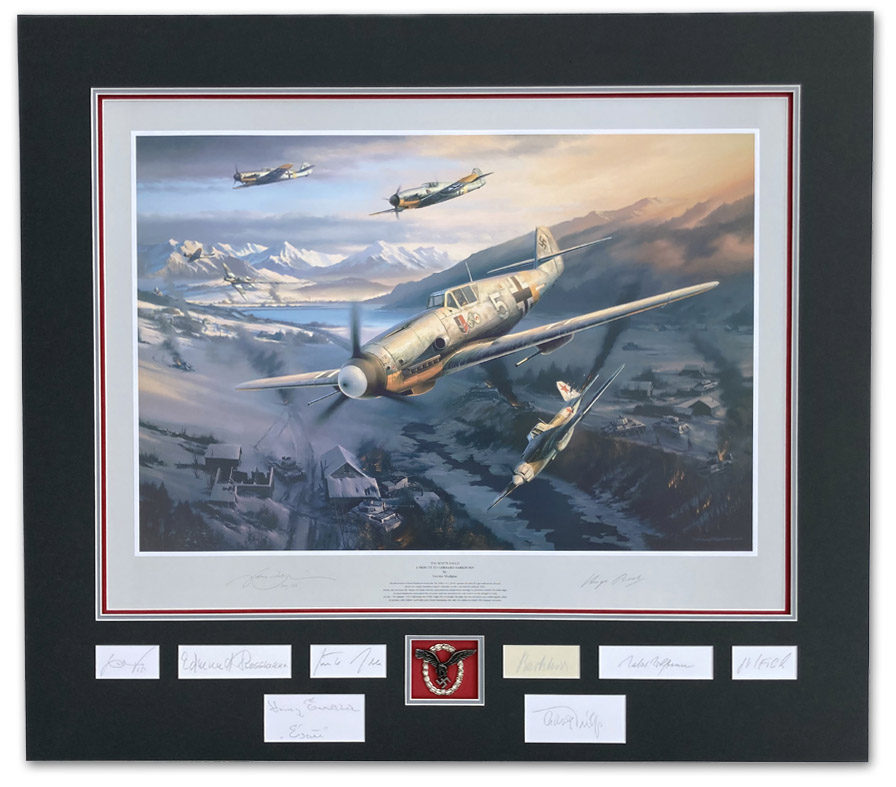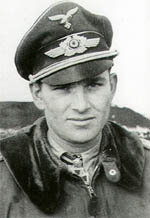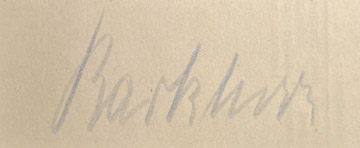The White Eagle
- A Tribute to Gerhard Barkhorn -
by Nicolas Trudgian
| - Includes wartime Gerhard Barkhorn signature - |
| Oberleutnant Gerhard Barkhorn leads the Me109Gs of 4./JG52 against Ilyushin Il-2 ground-attack aircraft ahead of a major Russian counter offensive in the Caucasus in January 1943. Below, the German 6th Panzer Division, heavily outnumbered, desperately attempt to prevent a Soviet breakthrough. Gerhard Barkhorn exceeded 100 victories and was awarded the Oak Leaves to the Knight’s Cross on the 11th January 1943, following his 105th claim. He eventually became the second most successful fighter pilot of all time, after fellow Luftwaffe pilot Erich Hartmann, the only two pilots to reach 300 claimed victories. |
| Archive presentation | Conservation matted with eight JG52 pilot signatures including Gerhard Barkhorn. | ||
| The print is signed by JG-54 Ace Hugo Broch and conservation mounted to include the signatures of eight JG-52 aces including the rare wartime signature of Gerhard Barkhorn. Also included is a high quality replica Lufwaffe pilot's badge. All materials used in the matting meet the highest conservation standards. - Overall mat size: 30⅜" x 34½" Shipping is free within the continental United States. Note: This item is not available for shipping outside the U.S.A. |
| The signatures | ||
| Gerhard Barkhorn - KCOS - (301 victories) | Günther Rall - KCOS - (275 victories) | Edmund Rossmann - KC - (93 victories) |
| Adolf Dickfeld - KCO - (136 victories) | Walter Wolfrum - KC - (137 victories) | Viktor Petermann - KC - (64 victories) |
| Franz Woidich - KC - (110 victories) | Heinz Ewald - KC - (84 victories) | Hugo Broch KC - (81 victories) |
|
|
| Barkhorn's original signature, signed on the reverse of a Feldpost form (German Military Mail Service) click signature for an example of a Feldpost form |
|
| Gerhard Barkhorn was born on 20 May 1919 at Königsberg in East Prussia. He joined the Luftwaffe in 1937 as a Fahnenjunker. On completion of his training he was posted to 3./JG 2. On 1 August 1940 Leutnant Barkhorn was transferred to 6./JG 52 based on the Channel Front. He flew his initial missions with his new unit during the Battle of Britain but did not confirm any victories during this time. He was, however, shot down into the Channel on one occasion but was rescued unhurt. Barkhorn achieved his first success during his 120th mission on 2 July 1941 over the Eastern Front. Thereafter he was to score steadily. Oberleutnant Barkhorn was awarded the Ritterkreuz on 23 August 1942 for 64 victories. After a two-month break away from the front he returned in early October. He recorded 14 victories in October, seven in November and 17 in December, including his 100th victory on 19 December. On 11 January 1943, he was awarded the Eichenlaub when he achieved his 105th victory. Hauptmann Barkhorn became Gruppenkommandeur of II./JG 52 on 1 September 1943, and led it until 15 January 1945. He claimed 24 victories in August, including his 150th on 8 August. He claimed 15 victories in September, 23 in November, including his 200th victory on 30 November 1943, and 28 in December, including seven on 28 December. On 23 January 1944, Barkhorn became the first fighter pilot to complete 1,000 combat missions. He achieved his 250th victory on 12 February, the second to do so. He was awarded the Schwertern on 2 March 1944 for 251 victories. Barkhorn’s success had not come without some cost. He was shot down nine times in his combat career. He baled out once and was wounded twice. On 31 May 1944, Barkhorn was flying his sixth mission of the day and, being fatigued, was not concentrating on keeping a good look-out when he was bounced by a Russian Airacobra fighter and shot down in Bf 109 Black 5”. He received severe wounds to his right arm and leg which put him out of action for four months. He returned to combat duty at the end of October. He claimed his 275th victim on 14 November. He recorded his 301st, and last, victory on 5 January 1945. On 16 January 1945, Major Barkhorn was transferred to take command of JG 6 serving on Reichsverteidigung duties based at Posen. He led the unit until 10 April 1945 but was still suffering the effects of his wounds and eventually relinquished command for another spell in hospital. On recovery, Barkhorn joined JV 44 commanded by Generalleutnant Adolf Galland and operating the Me 262 jet fighter. On 21 April 1945, on the last of only two operational missions flying the Me 262, Barkhorn’s starboard engine failed. He was obliged to break off an attack on an American bomber formation and return to his base at Riem. He was chased by the USAAF P-51 fighter escort, so set about landing his crippled machine in a clearing in some woods. In the resulting crash-landing the cockpit canopy, which he had opened to enable a quick escape, slammed shut on his neck. The incident put him back in hospital and out of the war. Post-war Barkhorn was one of the few noted Luftwaffe Experten who escaped being imprisoned by the Russians. However, he did become a prisoner of war of the Allies, finally being released by them in September 1945. He joined the Bundesluftwaffe in 1956, commanded Jabo G 31 “Boelcke” and rose to the rank of Generalleutnant. He retired in 1976. On 6 January 1983, during a winter storm on an autobahn near Köln, Barkhorn and his wife, Christl, were involved in a serious automobile accident. Christl died at the scene but Gerhard lingered in a hospital for two days before passing away on 8 January. |
|


